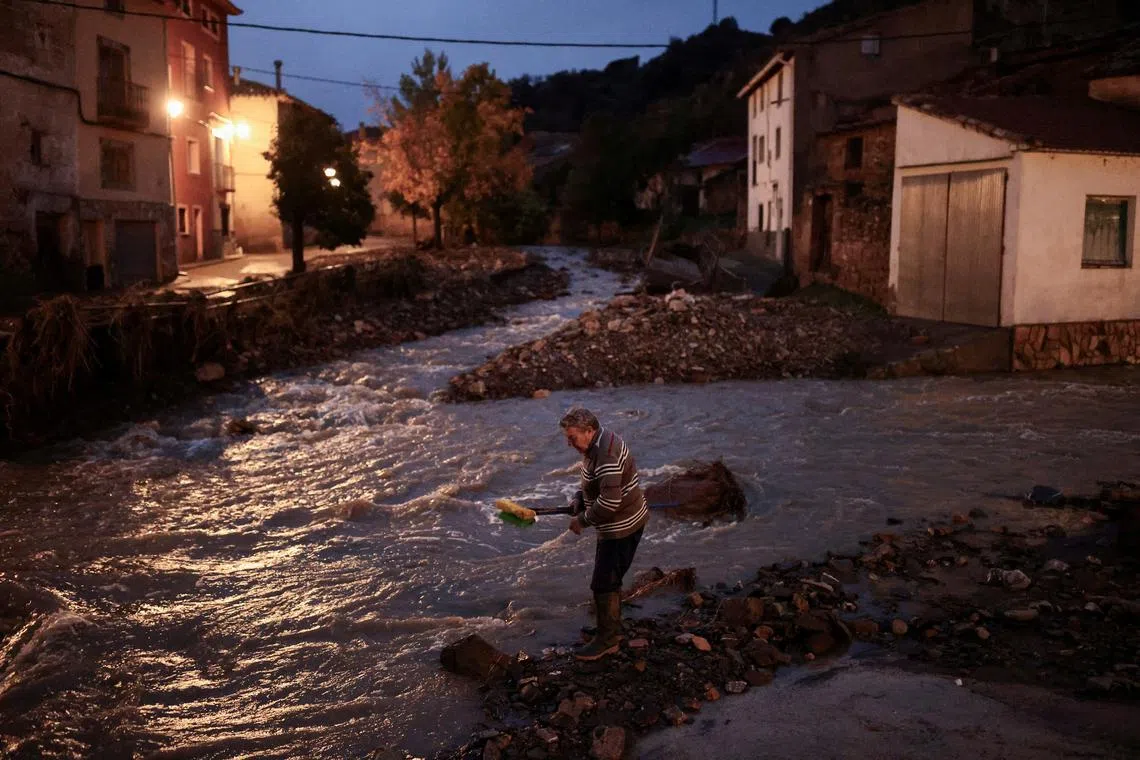Spanish floods kill 95 as year of rain falls in a day in Valencia
Sign up now: Get ST's newsletters delivered to your inbox
Follow topic:
LA ALCUDIA, Spain - At least 95 people have been killed in possibly the deadliest flooding to hit Spain in its modern history after torrential rain battered the eastern region of Valencia, sweeping away bridges and buildings, the local authorities said on Oct 30.
Meteorologists said a year’s worth of rain had fallen in eight hours in parts of Valencia on Oct 29, causing pile-ups on highways and submerging farmland in a region that produces two-thirds of the citrus fruit grown in Spain, a leading global exporter.
Residents in the worst-hit places described seeing people clambering onto the roofs of their cars as a churning tide of brown water gushed through the streets, uprooting trees and dragging away chunks of masonry from buildings.
“It’s a river that came through,” said Mr Denis Hlavaty, who waited for rescue on a ledge at the petrol station where he works in the regional capital. “The doors were torn away and I spent the night there, surrounded by water that was 2m deep.”
Defence Minister Margarita Robles told Cadena Ser radio station that a military unit specialised in rescue operations would start combing through the mud and debris with sniffer dogs in the worst-hit areas.
Asked if the number of victims was likely to increase, she said: “Unfortunately, we are not optimistic.” The teams have taken with them 50 mobile morgues.
Prime Minister Pedro Sanchez promised to rebuild infrastructure that had been destroyed and said in a televised address: “For those who at this moment are still looking for their loved ones, the whole of Spain weeps with you.”
Footage shot by emergency services from a helicopter showed bridges that had collapsed and cars and other vehicles piled on top of one another on highways between flooded fields outside the city of Valencia.
Trains to the cities of Madrid and Barcelona were cancelled due to the flooding, and schools and other essential services were suspended in the worst-hit areas, officials said.

Spain was hit by possibly the deadliest flooding in its modern history after torrential rain battered the eastern region of Valencia.
PHOTO: REUTERS
Power company i-DE, owned by Europe’s biggest utility, Iberdrola, said about 150,000 clients in Valencia had no electricity.
Emergency services in the region urged citizens to avoid all road travel and to follow further official advice. A military unit specialising in rescue operations was deployed in some places to help local emergency workers.
Some parts of Valencia such as the towns of Turis, Chiva and Bunol recorded more than 400mm of rainfall, leading state weather agency Aemet to declare a red alert on Oct 29. It was lowered to amber on Oct 30 as the rain eased.
There was also flooding in other parts of the country, including the southern region of Andalusia, and forecasters warned of more bad weather ahead as the storm moved in a north-easterly direction.
The regional weather service in Catalonia issued a red alert for the area around Barcelona, warning of high winds and hail, while Aemet placed the city of Jerez in Andalusia on red alert.
“(The flood waters) took away lots of dogs, lots of horses, they took away everything,” said construction worker Antonio Carmona, a resident of Alora in the southern region.
Deadliest Spanish floods since 1996
The death toll appeared to be the worst in Europe from flooding since 2021, when at least 185 people died in Germany.
It is the deadliest flood-related disaster in Spain since 1996, when 87 people died near a town in the Pyrenees mountains.
European Commission president Ursula von der Leyen said on X that Europe was ready to help. “What we’re seeing in Spain is devastating,” she said.
Asaja, one of Spain’s largest farmer groups, said it expected significant damage to crops.
Spain is the world’s largest exporter of fresh and dried oranges, according to trade data provider The Observatory of Economic Complexity, and Valencia accounts for about 60 per cent of the country’s citrus production, according to the Valencian Institute of Agriculture Investigations.
Scientists say extreme weather events are becoming more frequent in Europe due to climate change. Meteorologists think the warming of the Mediterranean, which increases water evaporation, plays a key role in making torrential rains more severe.
“Events of this type, which used to occur many decades apart, are now becoming more frequent, and their destructive capacity is greater,” said senior state meteorologist Ernesto Rodriguez Camino, a member of the Spanish Meteorological Association. REUTERS

